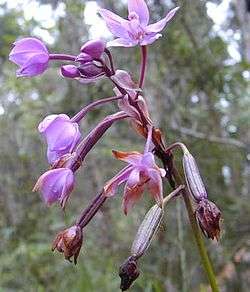Raceme
A raceme (/reɪˈsiːm/ or /rəˈsiːm/) is an unbranched, indeterminate type of inflorescence bearing pedicellate flowers — flowers having short floral stalks called pedicels — along its axis.[1] In botany, an axis means a shoot, in this case one bearing the flowers. In indeterminate inflorescence-like racemes, the oldest flowers are borne towards the base and new flowers are produced as the shoot grows, with no predetermined growth limit.[2] A plant that flowers on a showy raceme may have this reflected in its scientific name, e.g. Cimicifuga racemosa. A compound raceme, also called a panicle, has a branching main axis.[3] Examples of racemes occur on mustard (genus Brassica) and radish (genus Raphanus) plants.[3]
A spike is an unbranched, indeterminate inflorescence, similar to a raceme, but bearing sessile flowers (sessile flowers are attached directly, without stalks).[2] Examples occur on Malabar nut (Justicia adhatoda) and chaff flowers (genus Achyranthes).[3]
A spikelet can refer to a small spike, although it is primarily used to refer to the ultimate flower cluster unit in grasses (family Poaceae) and sedges (family Cyperaceae),[2] in which case the stalk supporting the cluster becomes the pedicel. A true spikelet comprises one or more florets enclosed by two glumes (sterile bracts), with flowers and glumes arranged in two opposite rows along the spikelet.[3] Examples occur on rice (species Oryza sativa) and wheat (genus Triticum), both grasses.[3]
An ament or catkin is very similar to a spike or raceme, "but with subtending bracts so conspicuous as to conceal the flowers until pollination, as in the pussy–willow, alder, [and] birch...".[4] These are sometimes called amentaceous plants.[4]
A spadix is a form of spike in which the florets are densely crowded along a fleshy axis, and enclosed by one or more large, brightly–colored bracts called spathes.[3] Usually the female flowers grow at the base, and male flowers grow above.[3] They are a characteristic of the Araceae family, for example jack–in–the–pulpit (species Arisaema triphyllum) and wild calla (genus Calla).[4]
Examples
-
.svg.png)
A raceme -

A spike -
.svg.png)
A spadix -

The inflorescence of Spathoglottis plicata, a terrestrial orchid, is a typical raceme
-

Every radiating unit in this inflorescence of a Cyperus sedge is a spikelet composed of small flowers (florets) arranged in two ranks
Derivation
From classical Latin racemus, cluster of grapes.[5]
See also
References
- ↑ Walters, Dirk R.; Keil, David J. (1 January 1996). Vascular Plant Taxonomy (4th ed.). United States: Kendall/Hunt Publishing Company. p. 602. ISBN 978-0-7872-2108-9.
- 1 2 3 Wofford, B. Eugene (1989). Guide to the Vascular Plants of the Blue Ridge. University of Georgia Press. pp. 10–15. ISBN 978-0-8203-2455-5.
- 1 2 3 4 5 6 7 Kumar, Vinay; Bhatia, S. S. (2013). Complete Biology for Medical College Entrance Examination. McGraw Hill Education Series (3rd ed.). McGraw Hill Education (India) Private Limited. p. 218. ISBN 978-1-259-06430-2.
- 1 2 3 Gilman, Daniel Coit., ed. (1907). The new international encyclopædia 10. Peck, Harry Thurston; Colby, Frank Moore. New York: Dodd, Mead and Company. p. 618.
- ↑ Oxford English Dictionary. Raceme 2. Bot. A type of inflorescence in which the flowers are arranged on short, nearly equal, lateral pedicels, at equal distances along a single elongated axis
| ||||||||||||||||||||||||||||||||||||||||||||||||||||||||||||||||